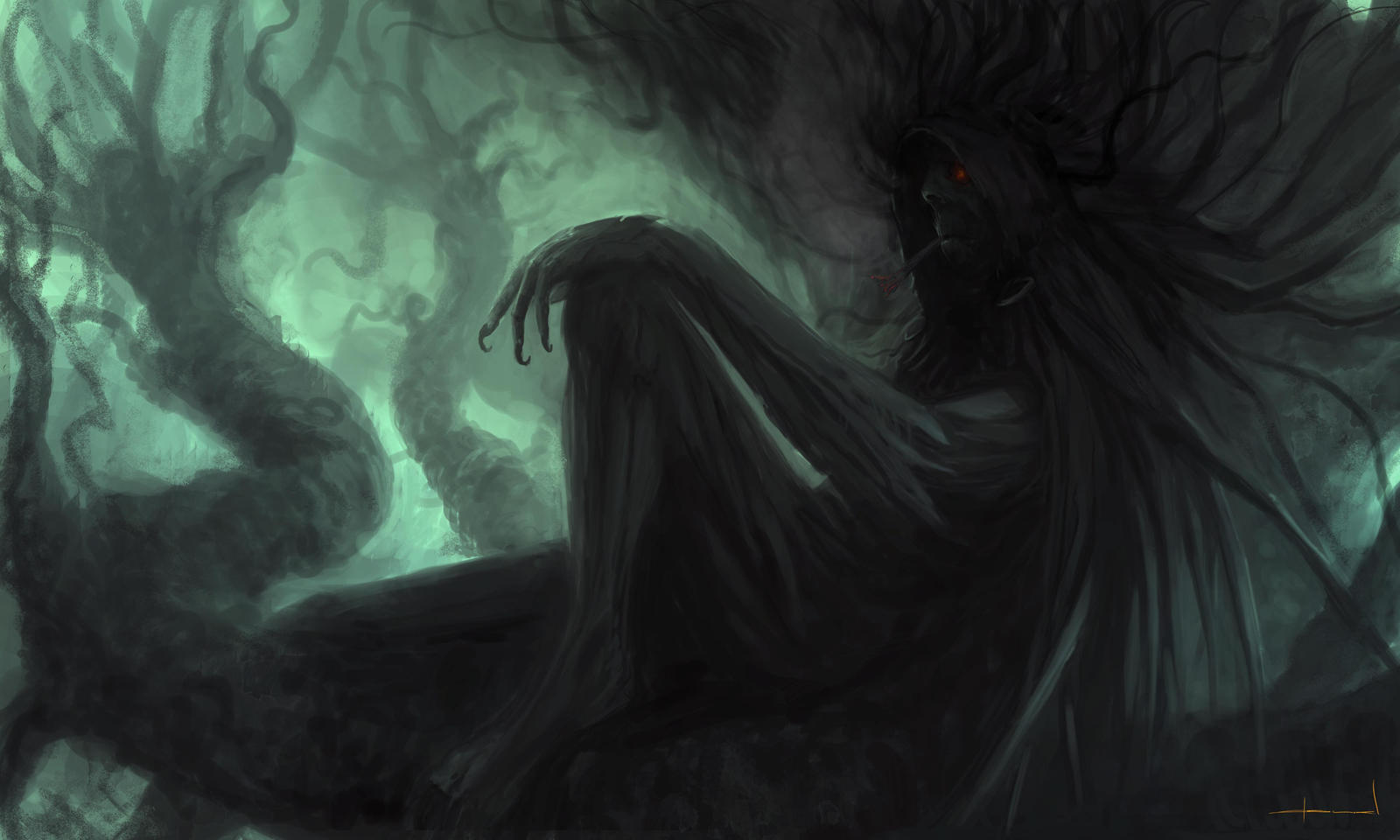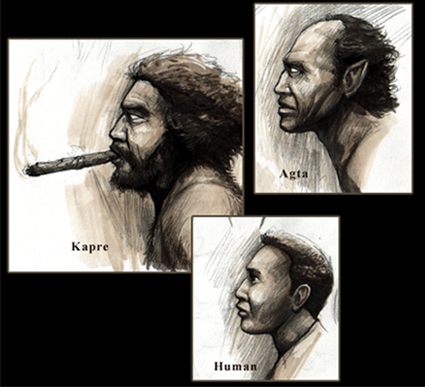One of the many joys I have in running The Aswang Project blog is reading the messages and emails I receives from curious minds. These often become the inspiration for future posts. In my short documentary, “Kapre: The Tree Dweller”, I traced back the first use of the term “cafre” being used to name mythical creatures. It turns out that, what would become a blanket term for dark tree-dwelling beings throughout the Philippines, was first applied to the Ilocano spirit/creature, the Pugot. This prompted a comment from Joseph S. stating, “Good watch. Thought that the kapre evolved from the agta though instead of the pugot.” Maria C. messaged, “So do you think an Agta is a variety of the Kapre? You mentioned it along with pugot, etc. in your documentary.” So, I’ve decided to create a post about the Agta. First, let’s clear up the questions mentioned above.
One puzzling aspect of the Kapre is where the name came from. It is generally believed that it came from the Islamic term ‘kafir’ meaning non-believer or infidel. But exactly how and why that happened is the question – especially since the Islamic population of the Philippines didn’t use the term. There is also a (now disproven) theory about black slaves in the Philippines being the cause of the folklore. In the documentary, I explain how the term ‘kafir’ made its way to Spain, and eventually the Philippines. Early reports on the folk beliefs of Filipino tribes have several accounts of various giant black spirits. But it was the Ilokano Pugot that smoked cigars in a tree before the Kapre took ownership of those characteristics. Spanish literature written in the Philippines during the late 19th century show that the word ‘cafre’ had evolved into a term describing an uncivilized or uncouth behavior. This descriptive word eventually became a general unifying umbrella term for all indigenous tall, black, tree-dwelling, creatures/spirits. Since Tagalog does not have an ‘f’ sound, the phonological alteration pronounces it Capre – Kapre after the introduction of the ABAKADA alphabet. So, the Agta would not be considered a ‘variety’ of kapre, but instead it would be considered one of the many tall, black, tree dwellers that have been (mis)classified under the umbrella term. In truth, the Kapre is a fairly recent invention that gained massive popularity in the early 20th century, but has always been based on other regional beings. The Agta is one of these.
About the Agta
Although the Agta is often attributed to the Eastern Visayan provinces of Samar and Leyte, it’s reach also extends into Masbate and Bohol. In “The Creatures of Philippine Lower Mythology”, Maximo Ramos gives the following description regarding the Agta.
Appearance: On September 18, 1963, Virginia Taglucop told folklorist Maximo Ramos that she and her sister were walking on a lonely footpath in Barrio Palanas, Masbate, in 1957 when they saw an agta sitting under a big santol tree (Sandoricum koetjape). The creature stood and walked toward them for a distance of twenty-five meters before they ran away. The creature was black and twice as tall as an ordinary man.
Domicile: The agta of the East Visayas “are said to live in mangroves and . . . swampy places.” The most frequented home of demons in the Philippines is the Ficus indica, commonly known as the balete tree.
Activities: The agta reported to have been seen in Barrio Palanas, Masbate, by the above informant carried a rattan cane, but this is the only creature shown by the data to be provided with this elegant appurtenance. The Agta reported most often in Leyte smoked a large cigar and it can usually be seen in a standing position. Benilda Moreno (from Barrio Gabas, Baybay, Leyte) said that an agta once ordered some night fishermen not to proceed, blocking their river route with large trees which it had knocked down to give force to its demand. Virginia Taglucop reported seeing an agta smoke, between eight in the evening and four the next morning, under a santol tree in which it resided.
According to Demetrio’s The Encyclopedia of Philippine Folk Beliefs and Customs Vol. 1 , “As a protection against the agta, a bottle filled with mercury (asugui) should always be carried, because they are afraid of mercury.”

The Legend of the Agta (Bohol)
Accidents are like lightning; they do not strike twice in the same place. That is the common belief, so when accidents repeatedly occur in a certain place, there is bound to be attached to it some kind of fantasy. When man, in his search for the explanation of phenomenon, fails to find it in natural laws, he ascribes the strange happenings to the supernatural.
The scene is kilometer post number nine on the national highway from Tagbilaran to Corella on the island of Bohol. One kilometer farther is the town of Corella. The road is an ordinary looking road. A depression lies between two slight elevations. The bulges on both sides were carved out and dug earth and rocks fill and bridge the gap, between which is a rice field about fifty meters wide. The road, approached from either side, is a downgrade drive of about one hundred meters till one reaches the culverts in the middle of the rice field, and then an up-grade drive of another one hundred meters to the opposite side. The height of the embankment at the center is about four meters. The grade is very gradual. The road is wide enough to accommodate two trucks running side by side. This innocent looking road will not present any danger or difficulty to drivers.
This place had been the scene of many accidents. On a Monday of April 13, 1950, a truck fell from the embankment, landing on its top in the rice field below. The vehicle was coming from Tagbilaran. It was full of passengers and goods bound for the marketplace in Corella. The driver was going twenty-five miles per hour. When the car was halfway on the downgrade, it lurched as if pushed from the right side. The driver tried to keep it in the middle of the road, but the truck had swerved to the left. His efforts at the wheel and the brakes proved futile. The truck headed for the bank, slid, and rolled over. Eighteen passengers were sent to the hospital with injuries ranging from bruises to broken shoulder-bones. The driver and several others escaped unscathed. The accident is the seventh to occur in the same place, according to the people of Corella. The sixth took place five months before that date during daytime. The car also lurched in the same spot but it swerved to the right and plunged from the embankment at the culvert into the rice paddy.

Old persons recall that when the road was yet a trail years ago, it was overgrown with wild bamboo groves. Late travelers at night told weird stories of having been blocked on the trail by a huge coffin with a skull on it, at other times by a big shapeless animal, and still at other times by a black shape of a man as tall as a tree. Late serenaders, drunkards, the gamblers, also claimed that they had seen these obstructions at one time or another when they passed the road in the dead of night. Some early churchgoers from the barrio said that they were once chased by an enormous cat when they passed the road one early dawn.
An official of the town and an old inhabitant were called to explain the accidents. They related that there were three old agtas’ who lived in an underground cave near the road. They said that they had seen them. The oldest of them had only two teeth in front. The official asked the people who were listening: “Do you want to see them? If you want to see them, just ask Inko Inciong, the old herbolario, any moonless night after the ringing of the church bells at eight o’clock at night (,animas), supposed to be the time when the spirits of the world go out of their secret abodes and wander on the earth, and you will see them.”
The official continued: “These agtas sometimes go to the culverts to enjoy the cool water there. Then they sit on the road to dry themselves in the mellow sunshine. When a car comes and the driver blows his horn, the agtas get out of the way; but if the driver does not blow his horn, and an agta happens to be in the road, the invisible monster simply goes on unconcernedly with his sunbath. When the car reaches him, he simply elbows it, and down the embankment, the car topples.”
This explanation has been repeated so many times that it is known to all drivers. That is why they always blow the horn when they pass the road daily. It has been found out that all cars that blow their horns when they pass that road never meet with any mishap. All the cars that did not blow their horns met accidents. Since that time, a road sign was placed at each end of the road which says: “Agta! Blow your horn.” But the district engineer who did not believe in fairy tales, put away the sign.
Sources:
Maximo Ramos, “The Creatures of Philippine Lower Mythology”, Phoenix Publishing 1991
M. C. Pajo, “Bohol Folktales,” pp. 133-37. Told by Juan Fernandez, Corella, Bohol
Damiana Eugenio, “Philippine Folk Literature: The Legends” UP Press, 2002
Fr. Francisco Demetrio S.J. “Encyclopedia of Philippine Folk Beliefs & Customs Vol. 1”, Xavier University Press, 1991
ALSO READ: PUGOT: Evolution of the Headless Filipino Ghoul
Jordan Clark is a Canadian born descendant of Scottish immigrants living on the homelands of the Lekwungen speaking peoples. His interest in Philippine myth and folklore began in 2004. Finding it difficult to track down resources on the topic, he founded The Aswang Project in 2006. Shortly after, he embarked on a 5 year journey, along with producing partner Cheryl Anne del Rosario, to make the 2011 feature length documentary THE ASWANG PHENOMENON – an exploration of the aswang myth and its effects on Philippine society. In 2015 he directed “The Creatures of Philippine Mythology” web-series, which features 3 folkloric beings from the Philippines – the TIKBALANG, KAPRE and BAKUNAWA. Episodes are available to watch on YouTube. Jordan recently oversaw the editing for the English language release of Ferdinand Blumentritt’s DICCIONARIO MITOLÓGICO DE FILIPINAS (Dictionary of Philippine Mythology) and is working on two more releases with fellow creators scheduled for release later this year. When his nose isn’t in a book, he spends time with his amazing Filipina wife of 20 years and their smart and wonderful teenaged daughter.


